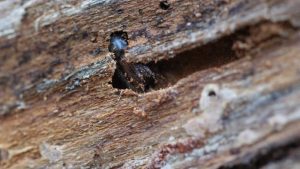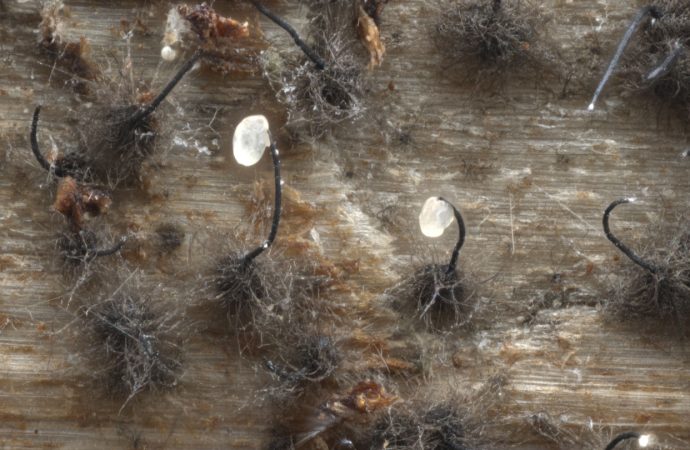Introduction Forests, those lush green giants covering our planet, have always held an air of mystery and enchantment. Yet, hidden beneath the towering trees and whispering leaves is a world that few have had the privilege to explore – a world where fungi, bark beetles, and trees engage in a cryptic dance of survival and
Introduction
Forests, those lush green giants covering our planet, have always held an air of mystery and enchantment. Yet, hidden beneath the towering trees and whispering leaves is a world that few have had the privilege to explore – a world where fungi, bark beetles, and trees engage in a cryptic dance of survival and renewal. In this article, we will journey into the depths of the forest to uncover the captivating story of how fungi act as nature’s GPS, guiding bark beetles to their tree targets. Dr. Monica G. Turner, a distinguished landscape ecologist, will be our guide on this expedition into the heart of the forest.
The Forest’s Whisperers: Bark Beetles & Fungi
In the heart of our forests, a silent symphony unfolds. Bark beetles, seemingly inconspicuous, are instrumental players in the intricate ecosystem orchestra. They owe their success to an unexpected partner – fungi. But what are these cryptic messages that bind these two unlikely allies together?
Bark beetles, often no larger than a grain of rice, are relentless in their quest for survival. These tiny insects bore into tree bark, causing harm and often death to the very trees they depend on. However, they are not alone in this endeavor. Fungi, the unsung heroes of the forest, play a critical role in guiding bark beetles to their tree targets.

Image by: https://stock.adobe.com/search?k=%22spruce+bark+beetle%22
Fungi’s Silent Language
To comprehend this alliance, we must first decipher the secret language of fungi. Dr. Turner delves into the fascinating world of mycelium networks, where these organisms communicate and navigate. Imagine a vast underground internet, connecting trees and fungi in ways we’re just beginning to fathom.
Mycelium, the thread-like structure of fungi, serves as the communication highway beneath our feet. It’s a network that allows trees to exchange vital information about their health, warn each other of impending threats, and even share nutrients. This exchange of information is crucial for the overall well-being of the forest.
Mycelium Network – The Forest’s Hidden Internet
| Key Points | Significance |
|---|---|
| Information Exchange | Vital for tree health |
| Nutrient Transfer | Facilitates forest resilience |
| Defense Mechanisms | Protects against pathogens |
The mycelium network acts as a conduit for cryptic messages between trees. When one tree is under attack by bark beetles, it can send out chemical signals through the mycelial network to alert nearby trees of the impending danger. This early warning system can be a lifesaver, allowing neighboring trees to activate their defense mechanisms.
Moreover, mycelium facilitates the transfer of nutrients between trees. Trees that are thriving can share excess nutrients with weaker ones, ensuring the forest’s overall resilience. This interconnectedness, driven by fungi, is the cornerstone of a thriving forest ecosystem.
Bark Beetles’ Quest for Survival
For bark beetles, survival is an ongoing struggle. These small insects face constant challenges, including harsh weather, predators, and limited resources. However, they have an ace up their sleeve – fungi. Dr. Turner explores the fascinating strategies these beetles employ to locate their next tree target and thrive in their ever-changing environment.
Bark beetles navigate the forest using a combination of visual cues and chemical signals. They can detect the volatile organic compounds (VOCs) released by trees when they are stressed or weakened. When a tree is under distress, it becomes an attractive target for these beetles. This is where the cryptic messages of fungi come into play.
The Symbiotic Dance: How It Works
The relationship between bark beetles and fungi is a true symbiosis. Discover how these organisms work together in perfect harmony, with the fungi acting as guides, while the beetles contribute to forest renewal.
Bark beetles are not just destroyers; they are also agents of renewal. When they bore into trees, they create openings for fungi to colonize. Fungi, in turn, help break down the tree’s cellulose, making it easier for them to consume. This mutual exchange ensures that dead and decaying trees are efficiently recycled, giving rise to new life in the forest.
Bark Beetles and Fungi – A Symbiotic Duo
| Features | Benefits |
|---|---|
| Tree Navigation | Efficient tree colonization |
| Decomposition | Enhances nutrient cycling |
| Ecosystem Balance | Maintains biodiversity |
While it might seem counterintuitive, this intricate dance between bark beetles and fungi contributes to the overall balance of the forest ecosystem. Dead and decaying trees provide habitat and nutrients for a variety of organisms, ensuring biodiversity within the forest.
Mapping the Mycelium Network
Dr. Turner takes us on a journey through the hidden world beneath our feet. Explore the complex mycelium networks, where fungi send their cryptic messages, shaping the fate of entire forests.
As we delve deeper into the forest floor, we discover a web of interconnected mycelium. This network acts as the internet of the forest, where fungi communicate with trees and other organisms. It’s a world of endless connections and cryptic messages, each contributing to the harmony of the forest.
The Climate Change Connection
As our climate changes, so do the rules of this intricate dance between fungi, bark beetles, and trees. Dr. Turner sheds light on the impact of climate change on these forest dynamics and what it means for our planet’s future.
Climate change is altering the conditions in which these cryptic messages are exchanged. Warming temperatures and shifting weather patterns can disrupt the delicate balance that has evolved over centuries. Bark beetles may thrive in warmer conditions, leading to more frequent outbreaks that can devastate forests.
Nature’s Intricate Web Unveiled
In this section, we unravel the web of life in our forests. Dr. Turner’s expertise helps us understand the profound implications of these cryptic messages and how they resonate throughout the ecosystem.
Every tree, every beetle, and every fungus plays a role in the intricate web of life in our forests. It’s a delicate dance that has evolved over millennia, and one that we must strive to protect. The cryptic messages exchanged among these forest inhabitants are not just a curiosity; they are the threads that hold our forests together.
Taking Action: Preserving Our Forests
Dr. Turner concludes by offering practical insights on how we can contribute to preserving our forests, ensuring the continued harmony between bark beetles, fungi, and trees.
Preserving our forests is not just a matter of conservation; it’s a matter of understanding and respecting the cryptic messages that sustain these ecosystems. As individuals, we can make a difference by supporting forest conservation efforts, reducing our carbon footprint, and advocating for policies that address climate change.
In a world filled with cryptic messages, Dr. Monica G. Turner’s research unveils the hidden symphony of our forests. Join her in this journey to understand how fungi guide bark beetles to their tree targets, and discover the crucial role we play in preserving this delicate balance. Together, we can ensure that the forest’s whisperers continue their vital work in our changing world. As you venture into the forest next time, remember the cryptic messages exchanged beneath your feet and the intricate dance of life that sustains our planet’s green giants.

















Leave a Comment
Your email address will not be published. Required fields are marked with *